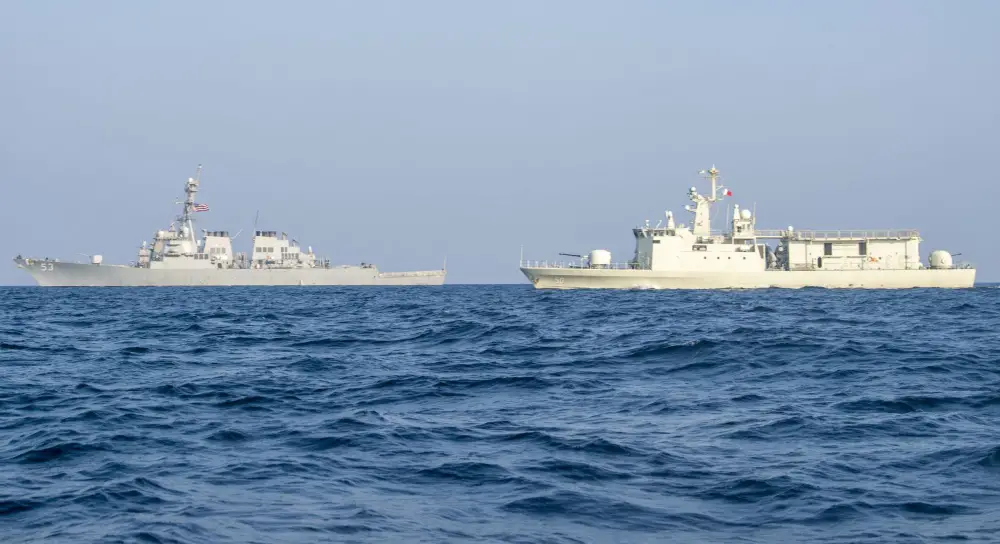Members of Coalition Task Force (CTF) Sentinel celebrated the organization’s first anniversary at Naval Support Activity (NSA) Bahrain, Nov. 5. During this the past year, CTF Sentinel has provided over watch for more than 1,100 partner nation flagged merchant vessels as they transited the Strait of Hormuz and the Bab el-Mandeb Strait. The task force has made almost 10,000 maritime awareness calls to reassure merchant vessels of task force presence. Sentinels and Sentries have also spent over 28,000 hours on station supporting the CTF Sentinel mission. Maritime patrol and reconnaissance aircraft flew more than 13,000 flight hours to providing surveillance during these missions.
More than 17,000 ships per year pass through the Bab el-Mandeb Strait and more than 42,000 ships per year pass through the Strait of Hormuz. Any closure of these waterways have international consequences, impacting economies all over the globe. These include Sentinels and Sentries. Sentinels, large naval vessels such as frigates and destroyers, provide over watch of two critical choke points at the Strait of Hormuz and the Bab el-Mandeb Strait. Sentries, smaller naval vessels such as patrol craft and corvettes, coordinate to patrol key transit lanes between the choke points. Additionally, airborne surveillance assets are employed to monitor the flow of traffic through the highest risk areas.
Opening its first command center on Nov. 7, 2019, CTF Sentinel was created under the International Maritime Security Construct’s (IMSC) mission to protect international commerce by safeguarding freedom of navigation from the Persian Gulf, through the Strait of Hormuz and the Bab el Mandeb Strait, to the Southern Red Sea. In July 2019, IMSC began as a coalition of only three nations: the United Kingdom, Australia and the United States. Bahrain joined soon after in August. In September, Saudi Arabia and the United Arab Emirates joined and, by November, Albania was a member of the growing coalition.
On Jan. 30, 2020, Commodore James Parkin became the first Royal Navy commodore to assume command. The coalition integration grew under his command, which is evident by the inclusion of the Australian frigate HMAS Toowoomba in the Sentinel mission in March, and a visit by Bahrain’s Crown Prince, His Royal Highness Prince Salman bin Hamad Al-Khalifa in March. In March, Lithuania became IMSC’s eighth member in spite of constraints stemming from COVID-19 spread mitigation. On April 30, CTF Sentinel welcomed its third commander, Royal Navy Commodore Rob Bellfield, who transitioned the task force from an emergent effort to an established regional presence.

On August 6, CTF Sentinel moved from its expeditionary headquarters into a permanent headquarters building, specifically designed to facilitate the coalition’s mission and enhance the flow of information, allowing for greater coordination in tracking merchant shipping as it transits through key waterways.Of particular note, on Aug. 13, a Sentinel ship captured the moment Iran used military force to conduct an armed boarding of the M/T Wila, a non-IMSC flagged vessel, in international waters. This was a blatant violation of international law that undermined the free flow of commerce. The exposure of this incident demonstrated CTF Sentinel’s commitment to the merchant community and resulted in the deterrence of further state-sponsored malign activity.
In fact, during the past year, there has been a significant reduction in state-sponsored malign activity in CTF Sentinel’s area of operations. The task force also made significant strides in engagement with the merchant community during this time, including the CTF Sentinel Maritime Trade Operation section liaising with the merchant industry through conferences, regular meetings with industry bodies and coordination with the United Kingdom Maritime Trade Organization (UKMTO) and U.S. Naval Cooperation and Guidance for Shipping (NCAGS). These efforts, combined with the continuous assessment of industry data, have built CTF Sentinel’s maritime domain awareness and strong relationship with commercial shipping.
CTF Sentinel’s engagement activities provided reassurance to all of industry by demonstrating that task force operations contribute to regional maritime security. CTF Sentinel also communicates to industry through the ‘Sentinel Watch,’ a monthly newsletter which provides a summary of security updates and events, and includes guidance on security incident reporting. In September, CTF Sentinel built upon its close ties with the merchant community by holding its bi-annual Stakeholders Conference to inform maritime industry professionals about regional security, task force capabilities and task force operations, as well as the future of the Sentinel mission.
On Oct. 27, the Republic of Estonia became the ninth member of IMSC signifying further international commitment to the security of these vital waterways. The next CTF Sentinel change of command is scheduled for Nov. 19, when Commodore Craig Wood, Royal Navy, will assume command. Coalition Task Force Sentinel continues to safeguard freedom of navigation and the free flow of commerce, and reassure merchant shipping by deterring and exposing state-sponsored malign activity that threatens security of the maritime commons in the Arabian Gulf, Gulf of Oman, Arabian Sea, Gulf of Aden and the Southern Red Sea.












